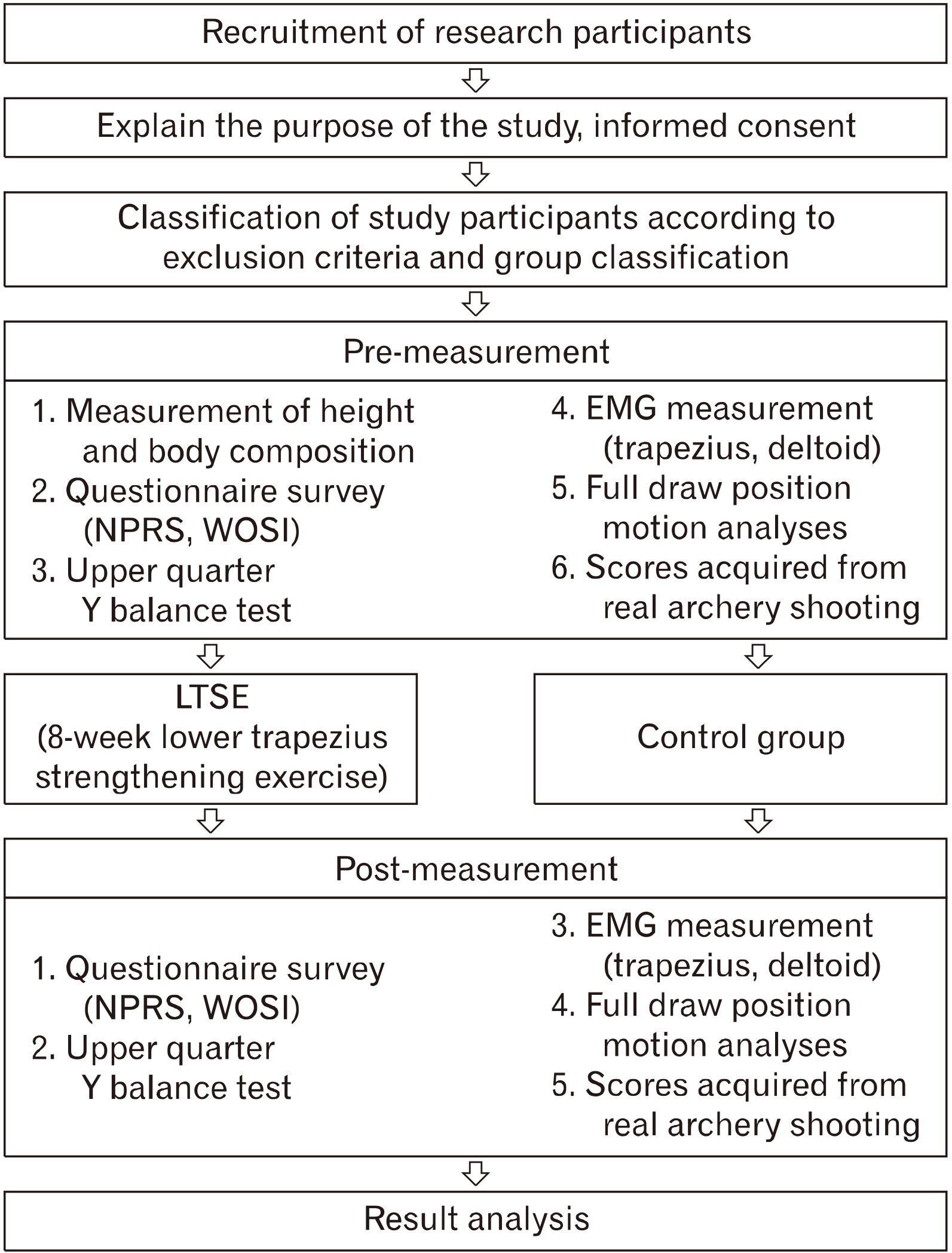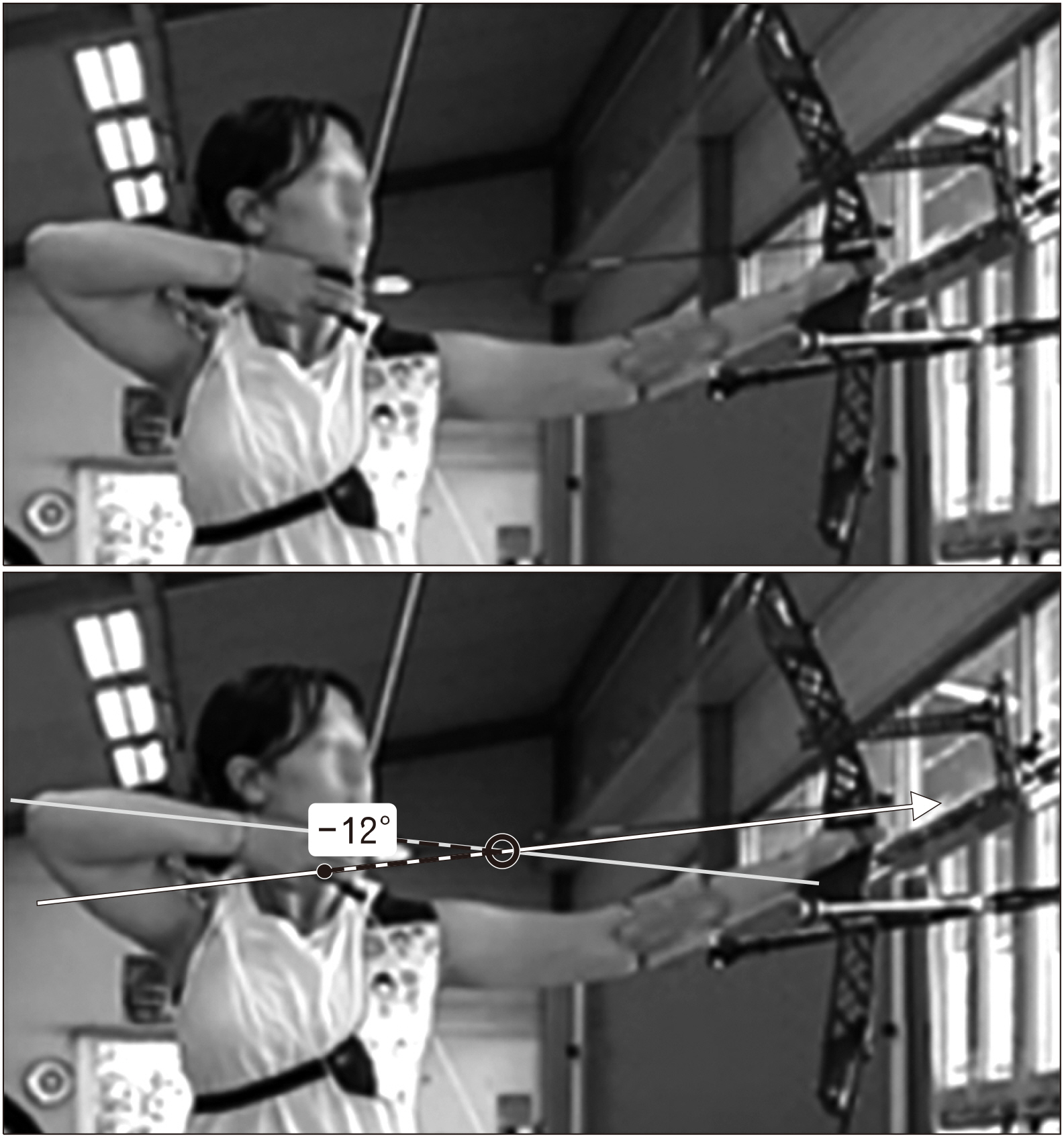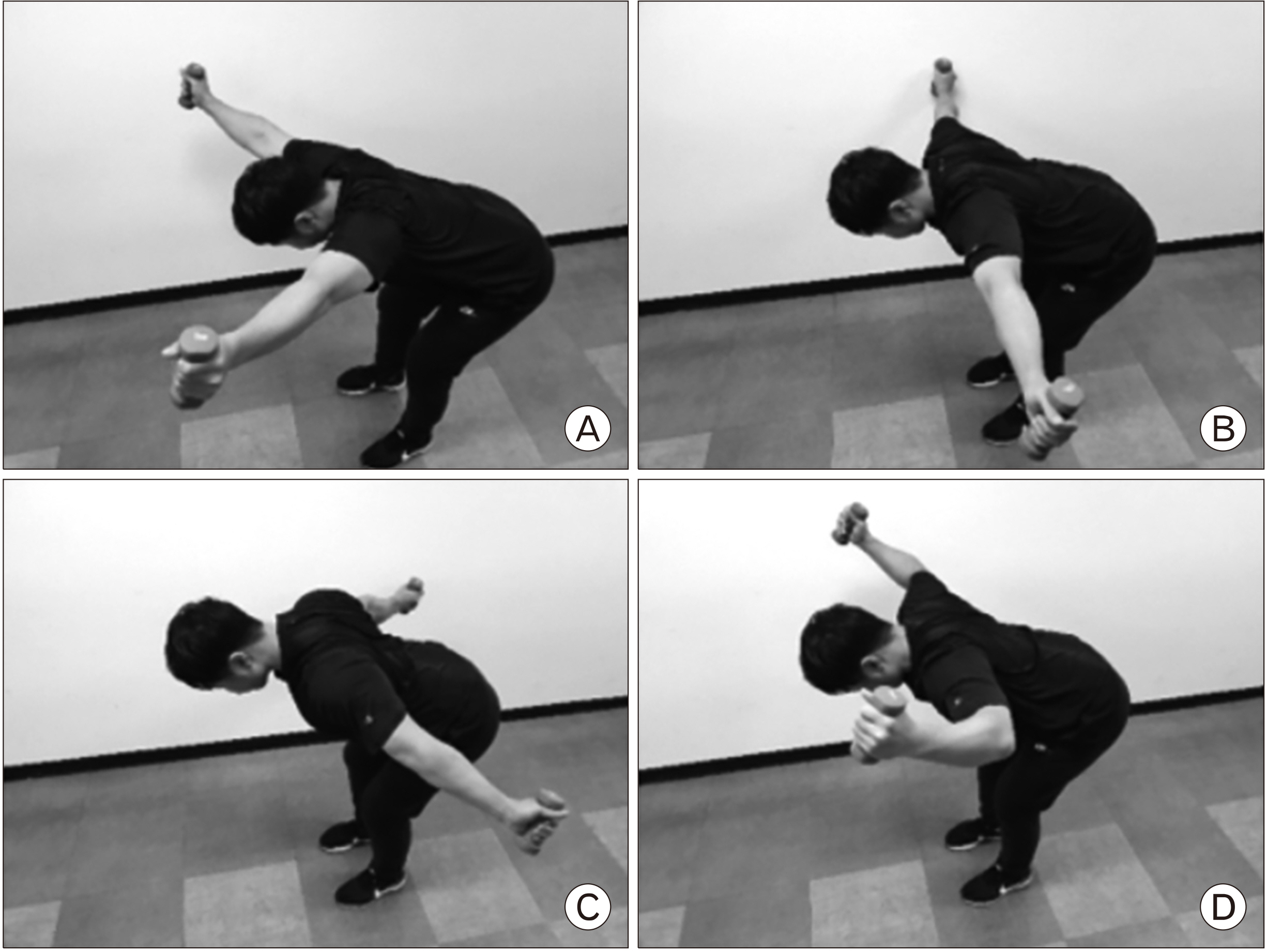Korean J Sports Med.
2020 Sep;38(3):171-181. 10.5763/kjsm.2020.38.3.171.
Effects of Lower Trapezius Strengthening Exercise on Shoulder Pain, Function and Archery Performance in Elite Archers
- Affiliations
-
- 1Department of Physical Education, Korea National Sport University, Seoul, Korea
- KMID: 2506075
- DOI: http://doi.org/10.5763/kjsm.2020.38.3.171
Abstract
- Purpose
The primary aim of this study was to examine the effects of 8-week lower trapezius strengthening exercise (LTSE) on shoulder pain, function and archery performance. The secondary aim was to identify main factors that have something to do with injury prevention and performance enhancement for elite archers.
Methods
Thirty-one elite archers were recruited and evenly assigned into the LTSE group (n=16) and into the control group (n=15) based on gender and athletes’ career. Shoulder pain was evaluated using Numeric pain rating scale (NPRS). Shoulder function was assessed using the Western Ontario Shoulder Instability Index (WOSI), upper quarter Y balance test (UQYBT), Trapezius and Deltoid muscle activity ratios by surface electromyography and the angle of scapula elevation/abduction by 3-dimentional motion analyses. Archery performance was estimated using draw force line (DFL) angle at full bowstring draw position and the scores acquired from real archery shooting. After the baseline measurements, the 8-week LTSEs were implemented and the post-exercise measurements were conducted.
Results
In the LTSE group, NPRS score and WOSI score significantly decreased after exercise program. The activity ratio of upper to lower trapezius muscle, scapula elevation angle and the DFL angle were also significantly reduced. The UQYBT scores significantly increased on both shoulders.
Conclusion
Eight weeks of LTSE has reduced shoulder pain in archers and improved shoulder function and performance factors.
Figure
Reference
-
1. Kim EK. 2005; Common sports injuries among national players in Korea. J Korean Med Assoc. 48:977–84. DOI: 10.5124/jkma.2005.48.10.977.
Article2. Mann DL, Littke N. 1989; Shoulder injuries in archery. Can J Sport Sci. 14:85–92.3. Cha SC, Kim CG, Jo SW, Lee IS. 2003; A study on the sports injuries of athletes who had visited oriental medical clinic in athletes' village at the 14th Busan Asian Games and oriental medical treatment. J Oriental Rehab Med. 13:131–45.4. Engebretsen L, Soligard T, Steffen K, et al. 2013; Sports injuries and illnesses during the London Summer Olympic Games 2012. Br J Sports Med. 47:407–14. DOI: 10.1136/bjsports-2013-092380. PMID: 23515712.
Article5. Soligard T, Steffen K, Palmer D, et al. 2017; Sports injury and illness incidence in the Rio de Janeiro 2016 Olympic Summer Games: a prospective study of 11274 athletes from 207 countries. Br J Sports Med. 51:1265–71. DOI: 10.1136/bjsports-2017-097956. PMID: 28756389.
Article6. Park JY, Lee SJ. 2010; Treatment of painful rotator interval widening after subcoracoid decompression in elite archer: case report. Clin Should Elbow. 13:280–5. DOI: 10.5397/CiSE.2010.13.2.280.7. Grover JK, Sinha AG. 2017; Prevalence of shoulder pain in competitive archery. Asian J Sports Med. 8:e40971. DOI: 10.5812/asjsm.40971.
Article8. Cools AM, Witvrouw EE, De Clercq GA, et al. 2002; Scapular muscle recruitment pattern: electromyographic response of the trapezius muscle to sudden shoulder movement before and after a fatiguing exercise. J Orthop Sports Phys Ther. 32:221–9. DOI: 10.2519/jospt.2002.32.5.221. PMID: 12014826.
Article9. Lin JJ, Hsieh SC, Cheng WC, Chen WC, Lai Y. 2011; Adaptive patterns of movement during arm elevation test in patients with shoulder impingement syndrome. J Orthop Res. 29:653–7. DOI: 10.1002/jor.21300. PMID: 21437944.
Article10. Peterson L, Renstrom P. 2016. Sports injuries: prevention and treatment. 4th ed. CRC Press;Boca Raton (FL):11. Cools AM, Witvrouw EE, Declercq GA, Danneels LA, Cambier DC. 2003; Scapular muscle recruitment patterns: trapezius muscle latency with and without impingement symptoms. Am J Sports Med. 31:542–9. DOI: 10.1177/03635465030310041101. PMID: 12860542.
Article12. Cools AM, Declercq GA, Cambier DC, Mahieu NN, Witvrouw EE. 2007; Trapezius activity and intramuscular balance during isokinetic exercise in overhead athletes with impingement symptoms. Scand J Med Sci Sports. 17:25–33. DOI: 10.1111/j.1600-0838.2006.00570.x. PMID: 16774650.
Article13. Shinohara H, Urabe Y, Maeda N, Xie D, Sasadai J, Fujii E. 2014; Does shoulder impingement syndrome affect the shoulder kinematics and associated muscle activity in archers? J Sports Med Phys Fitness. 54:772–9. PMID: 25350034.14. Niestroj CK, Schoffl V, Kupper T. 2018; Acute and overuse injuries in elite archers. J Sports Med Phys Fitness. 58:1063–70. DOI: 10.23736/S0022-4707.17.07828-8. PMID: 28944650.15. Kim SH, Jung HS, Choi HT, Ham JH. 2014; A study on the effects of shoulder stability exercise during 12 weeks on static balance in female archers. J Complementary and Alternative Med. 5:5–16.16. Ferraz MB, Quaresma MR, Aquino LR, Atra E, Tugwell P, Goldsmith CH. 1990; Reliability of pain scales in the assessment of literate and illiterate patients with rheumatoid arthritis. J Rheumatol. 17:1022–4. PMID: 2213777.17. Angst F, Schwyzer HK, Aeschlimann A, Simmen BR, Goldhahn J. 2011; Measures of adult shoulder function: Disabilities of the Arm, Shoulder, and Hand Questionnaire (DASH) and its short version (QuickDASH), Shoulder Pain and Disability Index (SPADI), American Shoulder and Elbow Surgeons (ASES) Society standardized shoulder assessment form, Constant (Murley) Score (CS), Simple Shoulder Test (SST), Oxford Shoulder Score (OSS), Shoulder Disability Questionnaire (SDQ), and Western Ontario Shoulder Instability Index (WOSI). Arthritis Care Res (Hoboken). 63(Suppl 11):S174–88. DOI: 10.1002/acr.20630. PMID: 22588743.18. Gorman PP, Butler RJ, Plisky PJ, Kiesel KB. 2012; Upper Quarter Y Balance Test: reliability and performance comparison between genders in active adults. J Strength Cond Res. 26:3043–8. DOI: 10.1519/JSC.0b013e3182472fdb. PMID: 22228174.19. SENIAM. 2019. Sensor location [Internet]. SENIAM;Nijmegen: Available from: http://www.seniam.org/. cited 2020 Aug 1.20. Green RA, Taylor NF, Watson L, Ardern C. 2013; Altered scapula position in elite young cricketers with shoulder problems. J Sci Med Sport. 16:22–7. DOI: 10.1016/j.jsams.2012.05.017. PMID: 22748568.
Article21. Ahmad Z, Taha Z, Hassan HA, Hisham MA, Johari NH, Kadirgama K. 2013; Biomechanics measurements in archery. Int Conf Mech Eng Res. 1:3.
Article22. World Archery. 2019. Target-archery [internet]. World Archery;Lausanne: Available from: https://worldarchery.org/Target-Archery. cited 2020 Aug 1.23. American College of Sports Medicine. 2014. ACSM's guidelines for exercise testing and prescription. 9th ed. Wolters Kluwer;Alphen aan den Rijn:24. Ekstrom RA, Donatelli RA, Soderberg GL. 2003; Surface electromyographic analysis of exercises for the trapezius and serratus anterior muscles. J Orthop Sports Phys Ther. 33:247–58. DOI: 10.2519/jospt.2003.33.5.247. PMID: 12774999.
Article25. Ellenbecker TS, Cools A. 2010; Rehabilitation of shoulder impingement syndrome and rotator cuff injuries: an evidence-based review. Br J Sports Med. 44:319–27. DOI: 10.1136/bjsm.2009.058875. PMID: 20371557.
Article26. Lin JJ, Hung CJ, Yang CC, Chen HY, Chou FC, Lu TW. 2010; Activation and tremor of the shoulder muscles to the demands of an archery task. J Sports Sci. 28:415–21. DOI: 10.1080/02640410903536434. PMID: 20432134.
Article27. Ludewig PM, Cook TM. 2000; Alterations in shoulder kinematics and associated muscle activity in people with symptoms of shoulder impingement. Phys Ther. 80:276–91. DOI: 10.1093/ptj/80.3.276. PMID: 10696154.
Article28. Hazar Z, Ulug N, Yuksel I. 2014; Upper Quarter Y-Balance Test score of patients with shoulder impingement syndrome. Orthop J Sports Med. 2(11_Suppl 3):2325967114S00275. DOI: 10.1177/2325967114S00275. PMCID: PMC4597741.
Article29. Korea Archery Association. 2011. Archery. 1st ed. Sewon;Seoul:30. Kim JH, Kim HY. 2005; Kinematic analysis on the release movement for expert archers. Korean J Phys Educ. 44:415–24.
- Full Text Links
- Actions
-
Cited
- CITED
-
- Close
- Share
- Similar articles
-
- Shoulder Pain Caused by Injuries in Korean Elite Archers
- The Characteristics of Shoulder Muscles in Archery Athletes
- Effect of Neck Rotating Directions on the Muscle Activity of Upper and Lower Trapezius during Shoulder External Rotation
- Comparison of the Lower Trapezius Muscle Activity during Three Different Shoulder Flexion Exercises in Healthy Subjects
- Comparison of the Electromyographic Activity in the Lower Trapezius Muscle According to Four Different Types of Exercises in Healthy Adults





